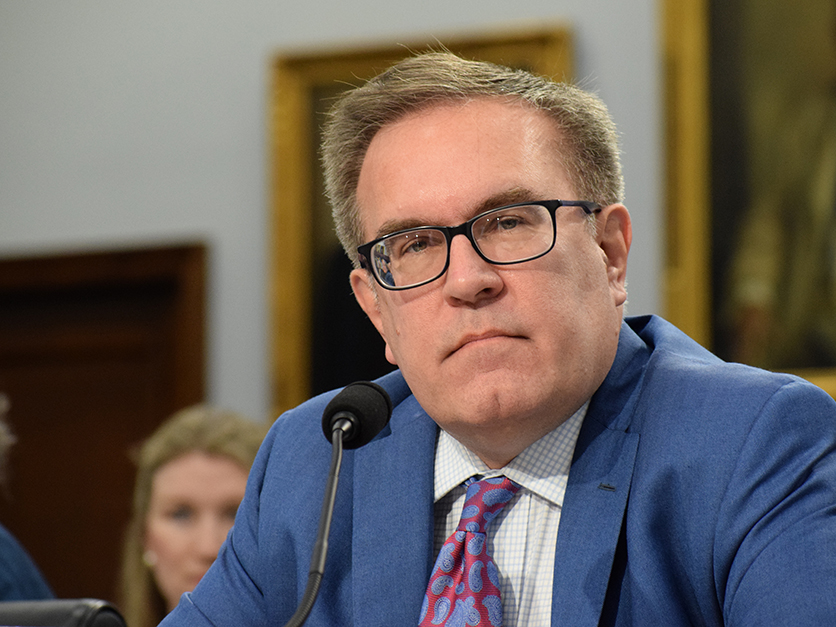The Environmental Protection Agency has issued interim registration decisions for atrazine, simazine and propazine that would allow the herbicides to continue to be used on corn and other crops.
For atrazine, the most widely used of the three products, the agency said it would be instituting label changes to reduce the potential for spray drift. Among the changes: Applicators must not apply during temperature inversions, and for both aerial and groundboom applications, applications cannot be made when wind speeds exceed 15 miles per hour at the application site. More requirements apply to aerial applications for wind speeds between 11-15 mph, and for wind speeds 10 mph or less.
The decision also contains new requirements for use of personal protective equipment to address potential risks to mixers/loaders.
EPA Administrator Andrew Wheeler announced the decisions at a roundtable in Niangua, Mo., with Republican Reps. Vicky Hartzler and Jason Smith of Missouri and farmers from the Missouri Farm Bureau and Missouri Corn Growers Association.
“Today’s news provides much needed regulatory certainty for farmers during a time when few things are certain,” Missouri Corn Growers Association CEO Gary Marshall, who chairs the Triazine Network, said in a press release issued by EPA.
“We appreciate today’s announcement from EPA Administrator Wheeler. We thank the agency on behalf of the farmers who rely on atrazine to fight problematic weeds and employ conservation tillage methods to reduce soil erosion and improve water and wildlife habitat.”
On average, approximately 58% of field corn or 53.3 million acres are treated with 62.3 million pounds of atrazine per year, the interim decision says. Corn acres in the Corn Belt states of Illinois, Indiana, Iowa, Missouri, and Ohio) and the northern Plains states of Colorado, Nebraska, North Dakota, South Dakota account for two-thirds of atrazine usage in the United States.
Wheeler said that later this fall the agency would be publishing its evaluation of the impacts of atrazine on endangered species, a critical step as the agency moves toward re-registering atrazine for use.
"EPA is serious about protecting jobs and our mission, which is protecting human health and the environment, and the agriculture industry is probably our greatest partner and our greatest ally in this regard," Wheeler said.
The interim decision raises the CE-LOC — Concentration Equivalent Level of Concern — allowed in watersheds before corrective action is required by atrazine registrants, from 10 parts per billion to 15 parts per billion, a level that environmental groups have said would lead to 50% more atrazine in waters. It also discontinues a requirement for atrazine drinking water monitoring.
"While having monitoring data specific to community water systems is useful, given the conclusions of the 2018 draft triazine human health risk assessments, EPA is discontinuing the requirement for atrazine drinking water monitoring (the AMP)," the interim decision says.
"Model-estimated atrazine concentrations, as well as measured concentrations for community water systems are well below the drinking water level of concern (DWLOC). The vast majority of atrazine samples from the AMP show concentrations below 1 ppb, while the highest atrazine concentration ever measured was 227 ppb, which is well below the triazine DWLOC of 580 ppb."
Interested in more coverage and insights? Receive a free month of Agri-Pulse.
Earlier this year, after releasing its proposed interim decision with the increased CE-LOC, EPA told Agri-Pulse it calculated the CE-LOC “to assess potential risk to the aquatic plant community from currently labeled atrazine uses. The number is not used as justification for then increasing allowable atrazine levels in waterways.”
“For the purpose of determining the need for any potential regulatory action or mitigation to protect aquatic plant communities during Registration Review, EPA will use the concentration of 15 [ppb] as a 60-day average, which is at the upper end of the distribution of values,” the interim decision says.
“The level can be compared to 60-day average concentrations of atrazine to identify watersheds that warrant further attention,” the interim decision says.
When the increase was proposed, Center for Biological Diversity scientist Nathan Donley said the CE-LOC “is a threshold that requires action to be taken to bring a waterway back into compliance. If you raise that level by 50%, then you are unequivocally allowing 50% more atrazine to be present in the water before action must be taken to reduce that level.”The center repeated that criticism Thursday, and said, "In allowing the continued use of atrazine, the EPA discarded safety precautions mandated under the Food Quality Protection Act that protect young children from pesticide exposures. In doing so the agency is ignoring multiple independent epidemiological studies finding that developing embryos and young children are at a high risk of harm from this pesticide."
By law, the registration review must be completed by October 2022.
For more news, go to www.Agri-Pulse.com


![Steve headshot 250x200[1]](http://www.agri-pulse.com/ext/resources/Headshots/Staff-Photos/thumb/Steve_Headshot_250x200[1].JPG?1738947158)
